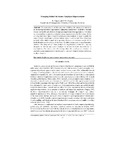| dc.contributor.author | Ongori, H. | |
| dc.contributor.author | Shunda, J.P.W. | |
| dc.date.accessioned | 2011-06-09T09:20:00Z | |
| dc.date.available | 2011-06-09T09:20:00Z | |
| dc.date.issued | 2008 | |
| dc.identifier.citation | Ongori, H. & Shunda, J.P.W. (2008) Managing behind the scenes: employee empowerment, The International Journal of Applied Economics and Finance, Vol. 2, No. 2, pp. 84-94 | en_US |
| dc.identifier.issn | 1991-0886 | |
| dc.identifier.uri | http://hdl.handle.net/10311/839 | |
| dc.description.abstract | The main objective of this study was to find out the strategies for success of employee empowerment in organisation to reduce employee turnover. In addition, the study focusses on the benefits and criticism of employee empowerment in organisations. Nowadays, empowerment has occupied a central point in many organisations in the 21st century. In this era of globalization, there is need for employees empowerment in order to enable the organisation to respond quickly to any changes in macro-environment. The methodology adopted in this study is quantitative approach, whereby a convenience sample of one hundred employees was selected for the study. The data was analyzed by using descriptive statistics. This study will contribute greatly to existing literature specifically in inspiring managers to develop appropriate strategies to nurture employee empowerment in organisations. The outcome from the findings shows that employee empowerment is essential to assist organisations to respond quickly to any environmental changes and to reduce employee turnover. | en_US |
| dc.language.iso | en | en_US |
| dc.publisher | Asian Network for Scientific Information, http://www.ansinet.org | en_US |
| dc.subject | Employees | en_US |
| dc.subject | Empowerment | en_US |
| dc.subject | management | en_US |
| dc.subject | strategies | en_US |
| dc.title | Managing behind the scenes: employee empowerment | en_US |
| dc.type | Published Article | en_US |
| dc.link | http://scialert.net/abstract/?doi=ijaef.2008.84.94 | en_US |

